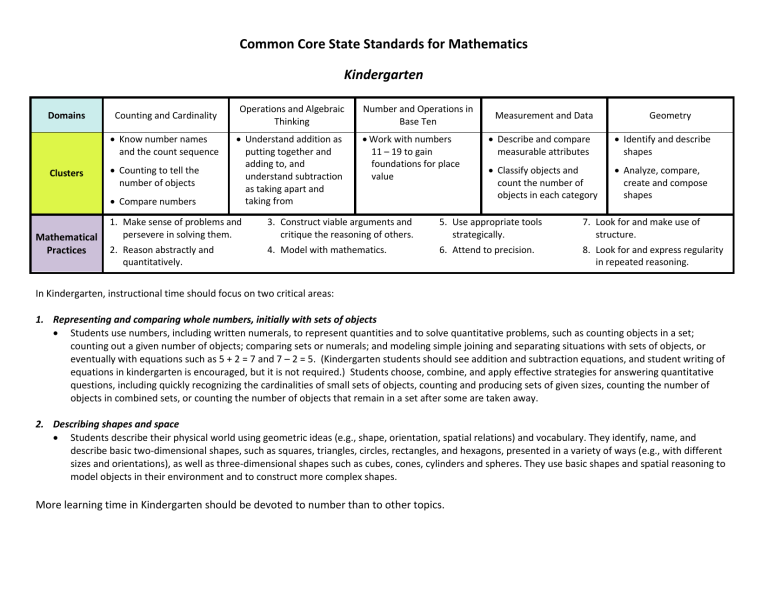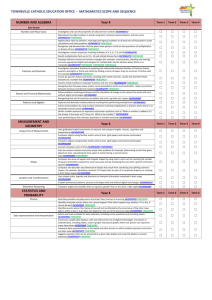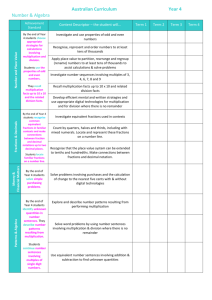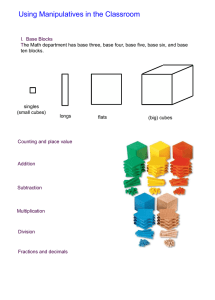Overview of Grades K-5

Common Core State Standards for Mathematics
Domains
Clusters
Counting and Cardinality
Know number names and the count sequence
Counting to tell the number of objects
Compare numbers
Operations and Algebraic
Thinking
Understand addition as putting together and adding to, and understand subtraction as taking apart and taking from
Kindergarten
Number and Operations in
Base Ten
Work with numbers
11 – 19 to gain foundations for place value
Measurement and Data
Describe and compare measurable attributes
Classify objects and count the number of objects in each category
Geometry
Identify and describe shapes
Analyze, compare, create and compose shapes
Mathematical
Practices
1.
Make sense of problems and persevere in solving them.
2.
Reason abstractly and quantitatively.
3.
Construct viable arguments and critique the reasoning of others.
4.
Model with mathematics.
5.
Use appropriate tools strategically.
6.
Attend to precision.
7.
Look for and make use of structure.
8.
Look for and express regularity in repeated reasoning.
In Kindergarten, instructional time should focus on two critical areas:
1.
Representing and comparing whole numbers, initially with sets of objects
Students use numbers, including written numerals, to represent quantities and to solve quantitative problems, such as counting objects in a set; counting out a given number of objects; comparing sets or numerals; and modeling simple joining and separating situations with sets of objects, or eventually with equations such as 5 + 2 = 7 and 7 – 2 = 5. (Kindergarten students should see addition and subtraction equations, and student writing of equations in kindergarten is encouraged, but it is not required.) Students choose, combine, and apply effective strategies for answering quantitative questions, including quickly recognizing the cardinalities of small sets of objects, counting and producing sets of given sizes, counting the number of objects in combined sets, or counting the number of objects that remain in a set after some are taken away.
2.
Describing shapes and space
Students describe their physical world using geometric ideas (e.g., shape, orientation, spatial relations) and vocabulary. They identify, name, and describe basic two-dimensional shapes, such as squares, triangles, circles, rectangles, and hexagons, presented in a variety of ways (e.g., with different sizes and orientations), as well as three-dimensional shapes such as cubes, cones, cylinders and spheres. They use basic shapes and spatial reasoning to model objects in their environment and to construct more complex shapes.
More learning time in Kindergarten should be devoted to number than to other topics.
Common Core State Standards for Mathematics
Grade 1
Domains
Clusters
Mathematical
Practices
Operations and Algebraic Thinking
2.
Reason abstractly and quantitatively.
Number & Operations in Base Ten Measurement and Data Geometry
Represent and solve problems involving addition and subtraction
Understand and apply properties of operations and the relationship between addition and subtraction
Add and subtract within 20
Work with addition and subtraction equations
1.
Make sense of problems and persevere in solving them.
Extend the counting sequence
Understand place value
Use place value understanding and properties of operations to add and subtract
3.
Construct viable arguments and critique the reasoning of others.
5.
Use appropriate tools strategically.
Measure lengths indirectly and by iterating length units
Tell and write time
Represent and interpret data
7.
Reason with shapes and their attributes
Look for and make use of structure.
4.
Model with mathematics. 6.
Attend to precision. 8.
Look for and express regularity in repeated reasoning.
In Grade 1, instructional time should focus on four critical areas:
1.
Developing understanding of addition, subtraction, and strategies for addition and subtraction within 20
Students develop strategies for adding and subtracting whole numbers based on their prior work with small numbers. They use a variety of models, including discrete objects and length-based models (e.g., cubes connected to form lengths), to model add-to, take-from, put-together, take-apart, and compare situations to develop meaning for the operations of addition and subtraction, and to develop strategies to solve arithmetic problems with these operations.
Students understand connections between counting and addition and subtraction (e.g., adding two is the same as counting on two). They use properties of addition to add whole numbers and to create and use increasingly sophisticated strategies based on these properties (e.g., “making tens”) to solve addition and subtraction problems within 20. By comparing a variety of solution strategies, children build their understanding of the relationship between addition and subtraction.
2.
Developing understanding of whole number relationship and place value, including grouping in tens and ones
Students develop, discuss, and use efficient, accurate, and generalizable methods to add within 100 and subtract multiples of 10. The compare whole numbers
(at least to 100) to develop understanding of and solve problems involving their relative sizes. They think of whole numbers between 10 and 100 in terms of tens and ones (especially recognizing the numbers 11 to 19 as composed of a ten and some ones). Through activities that build number sense, they understand the order of the counting numbers and their relative magnitudes.
3.
Developing understanding of linear measurement and measuring lengths as iterating length units
Students develop an understanding of the meaning and processes of measurement, including underlying concepts such as iterating (the mental activity of building up the length of an object with equal-sized units) and the transitivity principle for indirect measurement. (Note: students should apply the principle of transitivity of measurement to make direct comparisons, but they need not use this technical term.)
4.
Reasoning about attributes of, and composing and decomposing geometric shapes
Students compose and decompose plane or solid figures (e.g., put two triangles together to make a quadrilateral) and build understanding of part-whole relationships as well as the properties of the original and composite shapes. As they combine shapes, they recognize them from different perspectives and orientations, describe their geometric attributes, and determine how they are alike and different, to develop the background for measurement and for initial understandings of properties such as congruence and symmetry.
Common Core State Standards for Mathematics
Grade 2
Domains
Clusters
Mathematical
Practices
Operations and Algebraic Thinking
Represent and solve problems involving addition and subtraction
Add and subtract within 20
Work with equal groups of objects to gain foundations for multiplication
1.
Make sense of problems and persevere in solving them.
2.
Reason abstractly and quantitatively.
Number & Operations in Base Ten
Understand place value
Use place value understanding and properties of operations to add and subtract
3.
Construct viable arguments and critique the reasoning of others.
4.
Model with mathematics.
Measurement and Data
Measure and estimate lengths in standard units
Relate addition and subtraction to length
Work with time and money
Represent and interpret data
5.
Use appropriate tools strategically.
6.
Attend to precision.
Geometry
Reason with shapes and their attributes
7.
Look for and make use of structure.
8.
Look for and express regularity in repeated reasoning.
In Grade 2, instructional time should focus on four critical areas:
1.
Extending understanding of base-ten notation
Students extend their understanding of the base-ten system. This includes ideas of counting in fives, tens, and multiples of hundreds, tens, and ones, as well as number relationships involving these units, including comparing. Students understand multi-digit numbers (up to 1000) written in base-ten notation, recognizing that the digits in each place represent amounts of thousands, hundreds, tens, or ones (e.g., 853 is 8 hundreds + 5 tens + 3 ones).
2.
Building fluency with addition and subtraction
Students use their understanding of addition to develop fluency with addition and subtraction within 100. They solve problems within 1000 by applying their understanding of models for addition and subtraction, and they develop, discuss, and use efficient, accurate, and generalizable methods to compute sums and differences of whole numbers in base-ten notation, using their understanding of place value and the properties of operations. They select and accurately apply methods that are appropriate for the context and the numbers involved to mentally calculate sums and differences for numbers with only tens or only hundreds.
3.
Using standard units of measure
Students recognize the need for standard units of measure (centimeter and inch) and they use rulers and other measurement tools with the understanding that linear measure involves iteration of units. They recognize that the smaller the unit, the more iterations they need to cover a given length.
4.
Describing and analyzing shapes
Students describe and analyze shapes by examining their sides and angles. Students investigate, describe, and reason about decomposing and combining shapes to make other shapes. Through building, drawing, and analyzing two- and three-dimensional shapes, students develop a foundation for understanding attributes of two- and three-dimensional shapes, students develop a foundation for understanding area, volume, congruence, similarity, and symmetry in later grades.
Common Core State Standards for Mathematics
Grade 3
Domains
Clusters
Mathematical
Practices
1.
Operations and Algebraic Thinking
Represent and solve problems involving multiplication and division
Understand properties of multiplication and the relationship between multiplication and division
Multiply and divide within 100
Solve problems involving the four operations, and identify and explain patterns in arithmetic
Make sense of problems and persevere in solving them.
2.
Reason abstractly and quantitatively.
Number & Operations in Base Ten
Use place value understanding and properties of operations to perform multidigit arithmetic
3.
4.
Number & Operations:
Fractions
Develop understanding of fractions as numbers
Construct viable arguments and critique the reasoning of others.
Model with mathematics.
Measurement and Data
Solve problems involving measurement and estimation of intervals of time, liquid, volumes and masses of objects
Represent and interpret data
Geometric measurement: understand concepts of area and relate area to multiplication and to addition
Geometric measurement: recognize perimeter as an attribute of plane figures and distinguish between linear and area measures
5.
Use appropriate tools strategically.
6.
Attend to precision.
7.
Geometry
Reason with shapes and their attributes
Look for and make use of structure.
8.
Look for and express regularity in repeated reasoning.
In Grade 3, instructional time should focus on four critical areas (note: multiplication, division, and fractions are the most important developments):
1.
Developing understanding of multiplication and division and strategies for multiplication and division within 100
Students develop an understanding of the meanings of multiplication and division of whole numbers through activities and problems involving equal-sized groups, arrays, and area models; multiplication is finding an unknown product, and division is finding an unknown factor in these situations. For equal-sized group situations, division can require finding the unknown number of groups or the unknown group size. Students use properties of operations to calculate products of whole numbers, using increasingly sophisticated strategies based on these properties to solve multiplication and division problems involving single-digit factors. By comparing a variety of solution strategies, students learn the relationship between multiplication and division.
2.
Developing understanding of fractions, especially unit fractions (fractions with numerator 1)
Students develop an understanding of fractions, beginning with unit fractions. Students view fractions in general as being built out of unit fractions, and they use fractions along with visual fraction models to represent parts of a whole. Students understand that the size of a fractional part is relative to the size of the whole. For example, 1/2 of the paint in a small bucket could be less paint than 1/3 of the paint in a larger bucket; but 1/3 of a ribbon is longer than 1/5 of the same ribbon because when the ribbon is divided into 3 equal parts, the parts are longer than when the ribbon is divided into 5 equal parts. Students are able to use fractions to represent numbers equal to, less than, and greater than one. They solve problems that involve comparing fractions by using visual fraction models and strategies based on noticing equal numerators or denominators.
3.
Developing understanding of the structure of rectangular arrays and of area
Students recognize area as an attribute of two-dimensional regions. They measure the area of a shape by finding the total number of same-size units of area required to cover the shape without gaps or overlaps, a square with sides of unit length being the standard unit for measuring area. Students understand that rectangular arrays can be decomposed into identical rows or into identical columns. By decomposing rectangles into rectangular arrays of squares, students connect area to multiplication, and justify using multiplication to determine the area of a rectangle.
4.
Describing and analyzing two-dimensional shapes
Students describe, analyze, and compare properties of two-dimensional shapes. They compare and classify shapes by their sides and angles, and connect these with definitions of shapes. Students also relate their fraction work to geometry by expressing the area of part of a shape as a unit fraction of the whole.
Common Core State Standards for Mathematics
Grade 4
Domains
Operations and
Algebraic Thinking
Number & Operations in
Base Ten
Number & Operations:
Fractions
Measurement and Data Geometry
Clusters
Mathematical
Practices
1.
2.
Use the four operations with whole numbers to solve problems
Gain familiarity with factors and multiples
Generate and analyze patterns
Generalize place value persevere in solving them. understanding for multidigit whole numbers
Use place value understanding and properties of operations to perform multi-digit arithmetic
Make sense of problems and
Reason abstractly and quantitatively.
Extend understanding of fraction equivalence and ordering
Build fractions from unit fractions by applying and extending previous understandings of operations on whole numbers
Understand decimal notation for fractions, and compare decimal fractions
3.
Construct viable arguments and critique the reasoning of others.
4.
Model with mathematics.
5.
6.
Use appropriate tools strategically.
Solve problems involving measurement and conversion of measurements from a larger unit to a smaller unit
Represent and interpret data
Geometric measurement: understand concepts of angle and measure angles
Attend to precision.
7.
Draw and identify lines and angles, and classify shapes by properties of their lines and angles
Look for and make use of structure.
8.
Look for and express regularity in repeated reasoning.
In Grade 4, instructional time should focus on three critical areas:
1.
Developing understanding and fluency with multi-digit multiplication, and developing understanding of dividing to find quotients involving multi-digit dividends
Students generalize their understanding of place value to 1,000,000, understanding the relative sizes of numbers in each place. They apply their understanding of models for multiplication (equal-sized groups, arrays, area models), place value, and properties of operations, in particular the distributive property, as they develop, discuss, and use efficient, accurate, and generalizable methods to compute products of multi-digit whole numbers. Depending on the numbers and the context, they select and accurately apply appropriate methods to estimate or mentally calculate products. They develop fluency with efficient procedures for multiplying whole numbers; understand and explain why the procedures work based on place value and properties of operations; and use them to solve problems. Students apply their understanding of models for division, place value, properties of operations, and the relationship of division to multiplication as they develop, discuss, and use efficient, accurate, and generalizable procedures to find quotients involving multi-digit dividends. They select and accurately apply appropriate methods to estimate and mentally calculate quotients, and interpret remainders based upon the context.
2.
Developing an understanding of fraction equivalence, addition and subtraction of fractions with like denominators, multiplication of fractions by whole numbers
Students develop understanding of fraction equivalence and operations with fractions. They recognize that two different fractions can be equal (e.g., 15/9 =
5/3), and they develop methods for generating and recognizing equivalent fractions. Students extend previous understandings about how fractions are built from unit fractions, composing fractions from unit fractions, decomposing fractions into unit fractions, and using the meaning of fractions and the meaning of multiplication to multiply a fraction by a whole number.
3.
Understanding that geometric figures can be analyzed and classified based on their properties, such as having parallel sides, perpendicular sides, particular angle measures, and symmetry
Students describe, analyze, compare, and classify two-dimensional shapes. Through building, drawing, and analyzing two-dimensional shapes, students deepen their understanding of properties of two-dimensional objects and the use of them to solve problems involving symmetry.
Common Core State Standards for Mathematics
Grade 5
Domains
Clusters
Operations and
Algebraic Thinking
Write and interpret numerical expressions
Analyze patterns and relationships
Number & Operations in Base Ten
Understand the place value system
Perform operations with multi-digit whole numbers and with decimals to hundredths
Number & Operations:
Fractions
Use equivalent fractions as a strategy to add and subtract fractions
Apply and extend previous understandings of multiplication and division to multiply and divide fractions
Measurement and Data Geometry
Convert like measurement units within a given measurement system
Represent and interpret data
Geometric measurement: understand concepts of volume and relate volume to multiplication and to addition
5.
Use appropriate tools strategically.
6.
Attend to precision.
7.
Graph points on the coordinate plane to solve real-world and mathematical problems
Classify two-dimensional figures into categories based on their properties
Look for and make use of structure.
8.
Look for and express regularity in repeated reasoning.
Mathematical
Practices
1.
Make sense of problems and persevere in solving them.
2.
Reason abstractly and quantitatively.
3.
Construct viable arguments and critique the reasoning of others.
4.
Model with mathematics.
In Grade 5, instructional time should focus on three critical areas:
1.
Developing fluency with addition and subtraction of fractions, developing understanding of the multiplication of fractions and of division of fractions in limited cases (unit fractions divided by whole numbers and whole numbers divided by unit fractions)
Students apply their understanding of fractions and fraction models to represent the addition and subtraction of fractions with unlike denominators as equivalent calculations with like denominators. They develop fluency in calculating sums and differences of fractions, and make reasonable estimates of them.
Students also use the meaning of fractions, of multiplication and division, and the relationship between multiplication and division to understand and explain why the procedures for multiplying and dividing fractions make sense. (Note: this is limited to the case of dividing unit fractions by whole numbers and whole numbers by unit fractions.)
2.
Extending division to 2-digit divisors, integrating decimal fractions into the place value system and developing understanding of operations with decimals to hundredths, and developing fluency with whole number and decimal operation
Students develop understanding of why division procedures work based on the meaning of base-ten numerals and properties of operations. They finalize fluency with multi-digit addition, subtraction, multiplication, and division. They apply their understandings of models for decimals, decimal notation, and properties of operations to add and subtract decimals to hundredths. They develop fluency in these computations, and make reasonable estimates of their results. Students use the relationship between decimals and fractions, as well as the relationship between finite decimals and whole numbers (i.e., a finite decimal multiplied by an appropriate power of 10 is a whole number), to understand and explain why the procedures for multiplying and dividing finite decimals make sense. They compute products and quotients of decimals to hundredths efficiently and accurately.
3.
Developing understanding of volume
Students recognize volume as an attribute of three-dimensional space. They understand that volume can be quantified by finding the total number of same-size units of volume required to fill the space without gaps or overlaps. They understand that a 1-unit by 1-unit by 1-unit cube is the standard unit for measuring volume. They select appropriate units, strategies, and tools for solving problems that involve estimating and measuring volume. They decompose threedimensional shapes and find volumes of right rectangular prisms by viewing them as decomposed into layers of arrays of cubes. They measure necessary attributes of shapes in order to solve real world and mathematical problems.







